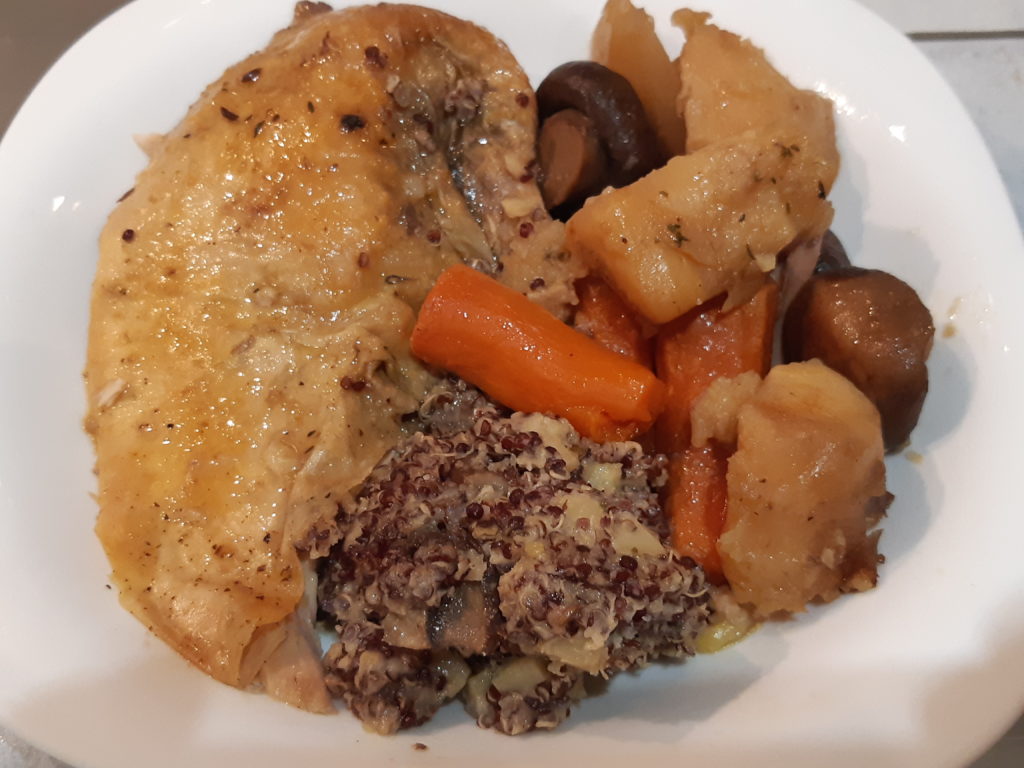I finally nailed something! The past two weeks have been a bit of a flop—not bad, exactly, but the family aproval rate wasn’t exactly skyrocketing.
This time, they really liked it.
This recipe is inspired by the Poudlarde lutée from Gastronogeek—loosely inspired… aaaanyway.
I’ve talked about guinea fowl before, but let me repeat myself: no, guinea fowl isn’t dry if you know how to cook it.
For 4 to 6 people, ideally as a main dish:
- 1 guinea fowl, cleaned
- 2 parsnips (or 300g)
- 4 carrots (or 300g)
- 300g potatoes
- 250g white or brown mushrooms
- 60g uncooked quinoa
- 15g breadcrumbs
- 15g flour
- 1 egg
- 1 clove of garlic
- 2 bay leaves or allspice leaves
- ¼ teaspoon of ground nutmeg
- A pinch of caraway seeds or cumin
- 4 sprigs of thyme
- 20g salted butter
- 1 full bottle of Armagnac or your local cooking brandy and a little common sense
this dish requires a larg cast iron casserole, if you don’t have one and can’t borrow one, you at least need something that goes in the oven with a closable lid… can be a big pan with a glass lid, a tajine dish, you know your cookware.
(And no, I’m not going to remind you every time—peel the vegetables before following the steps below.)
Start by setting aside a portion of the mushrooms and parsnips for the stuffing—roughly 80g of mushrooms and 80g of parsnips.
Cut the remaining vegetables into chunks of about 20g each for the garnish, but leave the mushrooms whole.
pre-cook the parsnips for 5 minutes, the carrots for 10 minutes, and the potatoes for 15 minutes. I cook the potatoes separately to prevent the starch from messing with the other vegetables, but that’s just me being a purist. You can just add them to the water one at a time. Then, set everything aside.
Pre-cook the quinoa for 15–20 minutes after rinsing it thoroughly.
Next, cut the 80g of reserved mushrooms into eighths—not slices, because slices turn into mush when cooked. You want them to hold their shape a bit to add texture to the stuffing.
Sauté the mushrooms in a little olive oil with ¼ of the garlic clove, finely minced.
Meanwhile, dice the reserved 80g of parsnips into a brunoise (small dice) and blanch them.
Once everything is ready, prepare the stuffing:
In a large bowl, mix together (without mashing): the blanched parsnip brunoise, the pre-cooked quinoa, the sautéed mushroom pieces, nutmeg, breadcrumbs, flour, beaten egg, a pinch of salt and pepper, the leaves from one sprig of thyme, and… voilà! We’re ready to roll. 🙂
Now, prepare the guinea fowl before stuffing it and placing it in the casserole. This mainly involves removing any leftover neck bits or offal from the cavity and checking that the bird has been properly plucked. Lightly oil the outside for even cooking.
Traditionally, you’re supposed to singe off any remaining down feathers with a flame (gas or blowtorch). If you don’t want your house to stink for a week, invest in a pair of tweezers instead—it costs around €5 and works just fine.
Stuff the guinea fowl. Don’t overdo it—if there’s a bit too much stuffing, just leave it out. Worst case, you can make a little croquette with the leftovers.
Now, I’m about to upset the culinary purists… I don’t truss stuffed poultry when cooking it in a cast iron casserole. I feel that constraining the bird during cooking stops the stuffing from expanding and might make it too dense. If it’s on a spit and empty, then yes, trussing is essential. But here, I don’t think it’s necessary.
Preheat your oven to 110°C (yes, that’s specific).
Preheat your casserole over medium-high heat with a drizzle of olive oil. Place the guinea fowl gently inside, sliding it to ensure it doesn’t stick. It should sizzle slightly. Add the remaining herbs, reserved vegetables, and mushrooms. Let it sizzle for about a minute, then deglaze with Armagnac. Don’t hold back—use at least 10cl. The alcohol will evaporate during cooking, so don’t worry about that.
Let the alcohol evaporate for 1–2 minutes, then cover and place the casserole in the oven.
And yes, I said seven hours—not a joke. Let the guinea fowl simmer for 3 hours before opening the casserole to baste it with its juices. Repeat the basting process at 3 hours, 5 hours, and 6 hours.
This is more of a convivial dish than a gastronomic one. I recommend serving it at the table rather than plating it individually.


